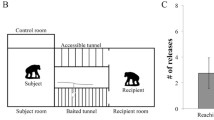Abstract
Social norms—generalized expectations about how others should behave in a given context—implicitly guide human social life. However, their existence becomes explicit when they are violated because norm violations provoke negative reactions, even from personally uninvolved bystanders. To explore the evolutionary origin of human social norms, we presented chimpanzees with videos depicting a putative norm violation: unfamiliar conspecifics engaging in infanticidal attacks on an infant chimpanzee. The chimpanzees looked far longer at infanticide scenes than at control videos showing nut cracking, hunting a colobus monkey, or displays and aggression among adult males. Furthermore, several alternative explanations for this looking pattern could be ruled out. However, infanticide scenes did not generally elicit higher arousal. We propose that chimpanzees as uninvolved bystanders may detect norm violations but may restrict emotional reactions to such situations to in-group contexts. We discuss the implications for the evolution of human morality.




Similar content being viewed by others
References
Aureli, F., & van Schaik, C. (1991). Post-conflict behaviour in long-tailed macaques (Macaca fascicularis): II Coping with uncertainty. Ethology, 89, 101–114.
Baker, A. C., & Aureli, F. (1997). Behavioural indicators of anxiety: an empirical test in chimpanzees. Behaviour, 134, 1031–1050.
BergmanT, J., Beehner, J. C. L. C. D., & Seyfarth, R. M. (2003). Hierarchical classification by rank and kinship in baboons. Science, 302, 1234–1236.
Boehm, C. (1994). Pacifying interventions at Arnhem Zoo and Gombe. In R. W. Wrangham, W. C. McGrew, F. B. M. de Waal, & P. G. Heltne (Eds.), Chimpanzee cultures (pp. 211–226). Cambridge: Harvard University Press.
Boesch, C. (2009). The real chimpanzee. Cambridge: Cambridge University Press.
Bowles, S., & Gintis, H. (2004). Persistent parochialism: trust and exclusion in ethnic networks. Journal of Economic Behavior and Organization, 55, 1–23.
Bräuer, J., & Hanus, D. (2012). Fairness in non-human primates? Social Justice Research, 25(3), 256–276.
Brosnan, S. F., & de Waal, F. B. (2014). Evolution of responses to (un) fairness. Science, 346(6207), 1251776.
Cacchione, T., & Burkart, J. M. (2012). Dissociation between seeing and acting: insights from common marmosets (Callithrix jacchus). Behavioural Processes, 89, 52–60.
Cacchione, T., & Krist, H. (2004). Recognizing impossible object relations: intuitions about support in chimpanzees (Pan troglodytes). Journal of Comparative Psychology, 118, 140–148.
Cheney, D. L., & Seyfarth, R. M. (1999). Recognition of other individuals’ social relationships by female baboons. Animal Behaviour, 58, 67–75.
Darwin, C. (1982). The descent of man, and selection in relation to sex. Princeton: Princeton University Press.
Das, M., Penke, Z., & Van Hooff, J. A. R. A. M. (1998). Postconflict affiliation and stress-related behaviour of long-tailed macaque aggressors. International Journal of Primatology, 19, 53–71.
de Waal, F. B. M. (1982). Chimpanzee politics: Power and sex among apes. London: Unwin Paperbacks.
de Waal, F. B. M. (1984). Sex differences in the formation of coalitions among chimpanzees. Ethology and Sociobiology, 5, 239–255.
de Waal, F. B. M. (1991). The chimpanzee’s sense of social regularity and its relation to the human sense of justice. American Behavioral Scientist, 34, 335–349.
de Waal, F. B. M. (1996). Good natured: The origins of right and wrong in humans and other animals. Cambridge: Harvard University Press.
de Waal, F. B. M. (2006). Primates and philosophers: How morality evolved. Princeton: Princeton University Press.
de Waal, F. B. M., & Hoekstra, J. A. (1980). Contexts and predictability of aggression in chimpanzees. Animal Behaviour, 28, 929–937.
de Waal, F. B. M., & van Hooff, J. A. R. A. M. (1981). Side-directed communication and agonistic anteractions in chimpanzees. Behaviour, 77, 164–198.
de Waal, F. B. M., & van Roosmalen, A. (1979). Reconciliation and consolation among chimpanzees. Behavioral Ecology and Sociobiology, 5, 55–66.
Ehrlich, P. R., & Levin, S. A. (2005). The evolution of norms. PLoS Biology, 3, 0943–0948.
Ellikson, R. C. (2001). The evolution of social norms: A perspective from the legal academy. In M. Hechter & K. D. Opp (Eds.), Social norms (pp. 35–75). New York: Russell Sage.
Fehr, E., & Fischbacher, U. (2004). Third-party punishment and social norms. Evolution and Human Behavior, 25, 63–87.
Fehr, E., & Gächter, S. (2002). Altruistic punishment in humans. Nature, 415, 137–140.
Flack, J. C., & de Waal, F. B. M. (2002). Any animal whatever: Darwinian building blocks of morality in monkeys and apes. In L. D. Katz (Ed.), Evolutionary origins of rorality: Cross-disciplinary perspectives (pp. 1–29). Thorverton: Imprint Academic.
Flack, J. C., Jeannotte, L. A., & de Waal, F. B. M. (2004). Play signaling and the perception of social rules by juvenile chimpanzees (Pan troglodytes). Journal of Comparative Psychology, 118, 149–159.
Flack, J. C., de Waal, F. B. M., & Krakauer, D. C. (2005). Social structure, robustness, and policing cost in a cognitively sophisticated species. American Naturalist, 165(5), E126–E139.
Flack, J. C., Girvan, M., de Waal, F. B. M., & Krakauer, D. C. (2006). Policing stabilizes constructions of social niches in primates. Nature, 439, 426–429.
Fraser, O. N., & Aureli, F. (2008). Reconciliation, consolation and postconflict behavioral specificity in chimpanzees. American Journal of Primatology, 70, 1114–1123.
Fraser, O. N., Stahl, D., & Aureli, F. (2008). Stress reduction through consolation in chimpanzees. Proceedings of the National Academy of Sciences, 105, 8557–8562.
Goodall, J. (1971). In the shadow of man. Boston: Houghton Mifflin.
Goodall, J. (1977). Infant killing and cannibalism in free-living chimpanzees. Folia Primatologica, 28, 259–282.
Goodall, J. (1983). Order without law. In M. Gruter & P. Bohannan L. (Eds.), Law, Biology and Culture (pp 50–62). Santa Barbara: Ross-Erikson.
Goodall, J. (1986). The chimpanzees of gombe: Patterns of behavior. Cambridge: The Belknap Press of Harvard University.
Haidt, J. (2007). The new synthesis in moral psychology. Science, 316, 998–1002.
Hamai, M., Nishida, T., Takasaki, H., & Turner, L. A. (1992). New records of within-group infanticide and cannibalism in wild chimpanzees. Primates, 33, 151–162.
Hamlin, J. K., Wynn, K., & Bloom, P. (2007). Social evaluation by preverbal infants. Nature, 450, 557–559.
Hechter, M., & Opp, K. D. (Eds.) (2001). Social norms. New York: The Russell Sage Foundation.
Horne, C. (2001). Sociological serspectives on the emergence on norms. In M. Hechter & K. D. Opp (Eds.), Social norms (pp. 3–34). New York: The Russell Sage Foundation.
Jasso, G. (2001). Rule finding about rule making: Comparison processes and the making of rules. In M. Hechter & K. D. Opp (Eds.), Social norms (pp. 348–394). New York: The Russell Sage Foundation.
Killen, M., & de Waal, F. B. M. (2000). The evolution and development of morality. In F. Aureli & F. B. M. de Waal (Eds.), Natural conflict resolution (pp. 352–372). London: University of California Press.
Koski, S. E., & Sterck, E. H. M. (2009). Post-conflict third-party affiliation in chimpanzees: what’s in it for the third party? American Journal of Primatology, 71, 1–10.
Kuhlmeier, V., Wynn, K., & Bloom, P. (2003). Attribution of dispositional states by 12-month-olds. Psychological Science, 14, 402–408.
Lang, P. J., Bradley, M. M., Cuthbert, M. M. (1997). Motivated attention: affect, activation and action. In P. J. Lang, R. F. Simons & M. T. Balaban (Eds.), Attention and orienting: Sensory and motivational processes (pp. 97–136). Hillsdale: Lawrence Erlbaum Associates.
Melis, A. P., Warneken, F., Jensen, K., Schneider, A. C., Call, J., & Tomasello, M. (2011). Chimpanzeeshelp conspecifics obtain food and non-food items. Proceedings of the Royal Society B, 278, 1405–1413.
Murray, C. M., Wroblewski, E., & Pusey, A. E. (2007). New case of intragroup infanticide in the chimpanzees of Gombe National Park. International Journal of Primatology, 28, 23–37.
Nishida, T., Kano, T., Goodall, J., Mcgrew, W. C., & Nakamura, M. (1999). Ethogram and ethnography of Mahale chimpanzees. Anthropological Science, 107, 141–188.
Parr, L. A. (2001). Cognitive and physiological markers of emotional awareness. Animal Cognition, 4, 223–229.
Parr, L. A., & Hopkins, W. D. (2000). Brain temperature asymmetries and emotional perception in chimpanzees, Pan troglodytes. Physiology and Behavior, 71, 363–371.
Poss, S. R., & Rochat, P. (2003). Referential understanding of videos in chimpanzees (Pan troglodytes), aoangutans (Pongo pygmaeus), and children (Homo sapiens). Journal of Comparative Psychology, 177, 420–428.
Preston, S., & de Waal, F. B. M. (2002). Empathy: its ultimate and proximate bases. Behavioral and Brain Sciences, 25, 1–72.
Rudolf von Rohr, C., Burkart, J. M., & van Schaik, C. P. (2011). Evolutionary precursors of social norms in chimpanzees: a new approach. Biology and Philosophy, 26, 1–30. doi:10.1007/s10539-010-9240-4.
Rudolf von Rohr, C., Koski, S. E., Burkart, J. M., Caws, C., Fraser, O. N., Ziltener, A., et al. (2012). Impartial third-party interventions in captive chimpanzees: a reflection of community concern. PLoS ONE, 7, e32494.
Sakamaki, T., Itoh, N., & Nishida, T. (2001). An attempted within-group infanticide in wild chimpanees. Primates, 42(4), 359–366.
Santos, L. R., & Hauser, M. D. (2002). A non-human primate’s understanding of solidity: dissociations between seeing and acting. Developmental Science, 5, F1–F7.
Sober, E., & Wilson, D. S. (1998). Unto others—the evolution and psychology of unselfish behavior. Cambridge: Harvard University Press.
Townsend, S. W., Slocombe, K. E., Thompson, M. E., & Zuberbühler, K. (2007). Female-led infanticide in wild chimpanzees. Current Biology, 17, R355–R356.
Troisi, A. (2002). Displacement activities as a behavioral measure of stress in nonhuman primates and human subjects. Stress, 5, 47–54.
van Schaik, C. P. (2000). Infanticide by male primates: The sexual selection hypothesis revisited. In C. P. van Schaik & C. H. Janson (Eds.), Infanticide by males and its implications (pp. 27–61). Cambridge: Cambridge University Press.
van Schaik, C. P., Burkart, J. M., Jaeggi, A. V., & Rudolf von Rohr, C. (2014). Morality as a biological adaptation—An evolutionary model based on the lifestyle of human foragers. In M. Christen, C. van Schaik, J. Fischer, M. Huppenbauer & C. Tanner (Eds.), Empirically informed ethics: Morality between facts and norms (pp. 65–84). Cham: Springer.
Wang, S. H., Baillargeon, R., & Brueckner, L. (2004). Young infants’ reasoning about hidden objects: evidence from violation-of-expectation tasks with test trials only. Cognition, 93, 167–198.
Warneken, F., & Tomasello, M. (2006). Altruistic helping in human infants and young chimpanzees. Science, 311, 1301–1303. doi:10.1126/science.1121448.
Warneken, F., Hare, B., Melis, A. P., Hanus, D., & Tomasello, M. (2007). Spontaneous altruism by chimpanzees and young children. PLoS Biology, 5, e184.
Wrangham, R. W. (1999). Evolution of coalitionary killing. Yearbook of Physical Anthropology, 110, 1–30.
Yamamoto, S., Humle, T., & Tanaka, M. (2009). Chimpanzees help each other upon request. PLoS One, 4, e7416.
Young, H. P. (2002). The power of norms. In P. Hammerstein (Ed.), Genetic and cultural evolution of cooperation (pp. 389–399). Cambridge: The MIT Press.
Acknowledgments
We thank Elizabeth Lonsdorf and Ian Gilby for generously sharing their film footage with us, and Igor Drieghe for his help with the video standardization. We also thank the Walter Zoo in Gossau and Zoo Basel, and especially animal keepers Angela Widmer and Stefan Lopez for their cooperation during the experiments, and Corinne Sober and Angela Ziltener for assistance with the experiments and Sereina Graber and Alexandra Kropac for assistance with the data analysis. We also thank Sonja Koski and two anonymous referees for fruitful discussions and comments on an earlier version of this manuscript. This work was funded by the University Priority Research Program in Ethics at the University of Zurich and the A. H. Schultz-Foundation of the Anthropological Institute and Museum at the University of Zurich.
Author information
Authors and Affiliations
Corresponding author
Rights and permissions
About this article
Cite this article
von Rohr, C.R., van Schaik, C.P., Kissling, A. et al. Chimpanzees’ Bystander Reactions to Infanticide. Hum Nat 26, 143–160 (2015). https://doi.org/10.1007/s12110-015-9228-5
Published:
Issue Date:
DOI: https://doi.org/10.1007/s12110-015-9228-5




